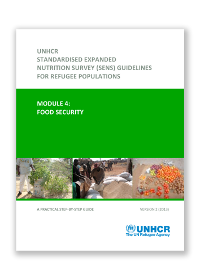OBJECTIVES AND INDICATORS
This Food Security module (Module 4) looks at three key sets of household-level indicators to define the current state of food security among the survey population:
- Access to food assistance and duration of the general food ration
- Use of negative coping strategies
- Level of household dietary diversity
Access to food assistance and duration of the general food ration, to be assessed in refugee populations dependent on food assistance, will provide information on the food assistance system. The extent to which negative coping strategies are used is indicative of the overall stress placed on the surveyed population to meet their food and other basic needs. Dietary diversity reflects the surveyed populations’ final access to food, with or without the use of coping strategies. In addition, guidance and recommendations on how to compile data on the performance of the in-kind food aid distribution system to help interpreting the results found at the household level is included as a tool.
The objectives are as follows:
- To determine the coverage of ration cards and the duration the general food ration lasts for recipient households.
- To determine the extent to which negative coping strategies are used by households.
- To assess household dietary diversity using the Household Dietary Diversity Score (HDDS).
If the survey is conducted in refugee contexts where there is no food assistance, objective 1 should be excluded.
KEY MESSAGES
- Food insecurity is one of the causes of undernutrition. It directly affects the nutritional status of an individual. It is a direct cause of malnutrition in terms of dietary intake and an underlying cause in terms of access to and utilisation of food. Improving overall food security is therefore critical to improved nutrition, health and long-term development of children and other household members, and this is why collecting food security information is important.
- The inclusion of this food security module in routine nutrition surveys will provide basic information on the existing food security situation among the surveyed population.
- Additional assessments will be required to gain a more detailed understanding of the causes and impacts of food insecurity, its dynamics and likely evolution in time, as well as for analysing the impact of responses. There are various methods for food security assessments and it is recommended to partner with experienced organisations such as WFP, ACF, Save the Children, or Oxfam to conduct these assessments.
- The majority of indicators proposed in this module have already been used and tested in previous nutrition surveys conducted in refugee populations, and the methods are based on international guidelines (by entities such as FANTA and FAO), that have been adapted to the refugee context.
- The standard SENS questionnaire adapted to the local context should be used for the collection of data on household dietary diversity, general food ration, and negative coping strategies.
- The standard reporting format for food security indicators should be followed in all nutrition survey reports produced in refugee contexts.
- Interpretation of the results will require qualitative contextual analysis.
- Providing good quality training to survey teams and supervising them well will help ensure that data are reliable.
CAUTION!
When interpreting the HDDS results and comparing them from year to year, it is essential to consider when the nutrition survey was conducted in relation to the food distribution cycle. The general in-kind food aid distribution usually lasts more than one day and may be organised by family size, hence the surveyed households will be at different times of the cycle which may have an impact on the HDDS results and this needs to be considered in interpreting the data. You should also provide an explanation on the season when the survey was conducted and its impact on the overall food availability. For example: “The survey was conducted during the annual lean season, during which the overall food availability is limited. It is hence likely that the household dietary diversity score is lower than it would be e.g. after the harvest.” Note also any extraordinary event that may have affected household dietary intake, such a drought or a festivity.
Downloads
Tool 1 – Analysis Food Aid Flows Guidance ![]()
![]()
Tool 2 – Analysis Food Aid Flows Graphs ![]()

